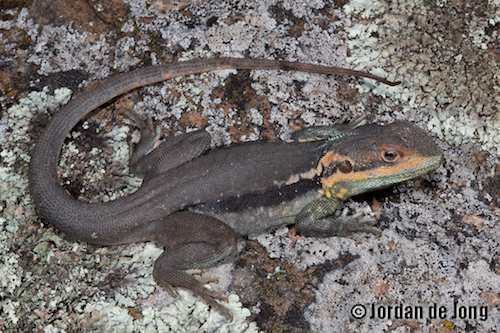Kingdom Animalia Class Reptilia Family Agamidae Phylum Chordata Rank Species | Subphylum Vertebrata Suborder Iguania Subfamily Amphibolurinae Genus Ctenophorus Order Scaled reptiles | |
 | ||
Similar Ctenophorus, Ctenophorus fionni, Ctenophorus pictus, Ctenophorus ornatus, Ctenophorus reticulatus | ||
Ctenophorus decresii, also known as the Tawny Dragon, is a species of lizard commonly found in Australia.
They are a member of the Ctenophorus genus, which is a very diverse group of lizards found throughout the world. The entire genus of lizards is sexually dimorphic. Neck and overall coloration distinguishes male lizards from female and juvenile lizards.
Most often C. decresii are found in rocky areas throughout Australia. However, their habitat varies as they are found in a few distinct locations throughout Australia. Scientists have identified the different populations of lizards as separate lineages due to their geographic isolation. The three lineages of C. decresii are the northern, southern, and NSW lineages. The entire Ctenophorus genus maintains a generally constant body shape, adapted for the Australian climate.
Polymorphism
Ctenophorus decresii are known to display polymorphisms in their throat coloration. Within the species of C. decresii, the morphs can range from grey and white to a bright red. Some of the variants found throughout the world include multi-colored, grey, yellow, orange, blue and red throated lizards. This variation comes from the diverse geographic locations C. decresii can be found in, such as, South Australia, New South Wales and other areas throughout Australia. One geographic location may favor a certain throat color for C. decresii, while a different location may prefer a different color.
Although there is a lot of diversity in throat colors, the color variants in the throats are discrete, meaning individual lizards morphology could be placed into specific categories After using objective methods to identify the color morphs, statistical tests were run. The tests analyzed variation based on granularity, segmentation, and comparison with visual background. One group of lizards had similar granularity, segmentation, and coloration. Another group also had similar granularity, segmentation and coloration that differed from the first group. There were very few lizards with in between phenotypes. However, within the categories, there still is slight variation in the shades of colors of the lizards. Because throat coloration is a discrete trait, it is highly heritable. This is a key reason that the discrete color variation has been maintained over multiple generations. The offspring will have similar or the same coloration as the parents, therefore making the coloration carryout over generations.
C. decresii's diversity in discrete throat color may be caused by a combination of sexual selection and natural selection.
The C. decresii throat colors can be classified into two main, discrete categories—dull and bright colored. The dull colored throats give lizards a fitness advantage because the lizards are harder for predators, like birds, to see. The dull throats allow the lizards to avoid predators and survive longer; therefore, this trait became more prevalent in that population of lizards.
However, bright colored throats also give the lizards a fitness advantage because the bright colored throats attract more females, and therefore those males are more likely to reproduce. Although the bright colored throats increases the likelihood of being eaten by predators, it also increases their sexual success. Therefore, the prevalence of bright colored throats is maintained in this population of lizards. Based on the conflicting benefits of dull and bright colored throats, it is understandable that both morphs have been maintained in this species. Both traits give the lizards a different evolutionary advantage.
